Germany is over 137,000 square miles of forested hills, farmland, tall mountains, valleys, and sandy plains. The country receives over 30 million tourists each year, which is no surprise given its scenic beauty and rich culture. Germany is well-known across the world for its higher education, beer obsession, the automotive industry, and as the birthplace of classical music. Discover the 11 largest cities in Germany by land size and learn about their attractions.
This article covers the largest cities in Germany by area. If you are looking for the largest cities in Germany by population, check out this article.
Berlin
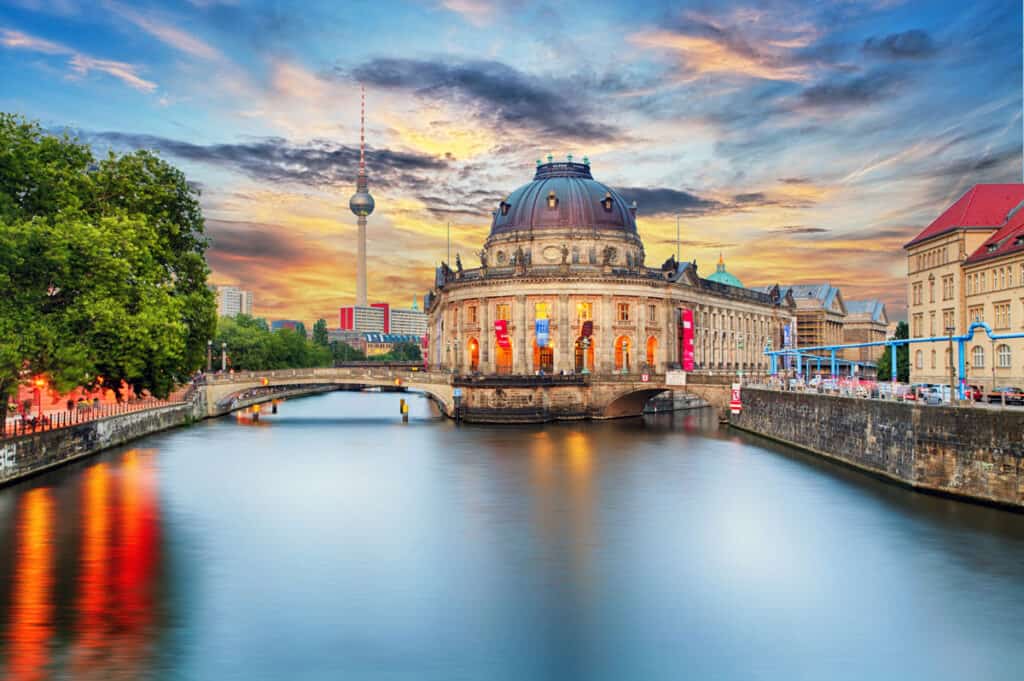
Berlin is Germany’s capital city and is located in the Northeastern part of the country. It is known for its art, architecture, culture, and universities.
©iStock.com/TomasSereda
Land Size: 11,794 sq. miles (metro), 344 sq. miles (city)
Population: 6.1 million (metro)
Location: Berlin is the largest city in Germany by both population and area. It is the capital city located in Northeastern Germany. And it resides in an area of low-lying marshy woodlands, which is part of the Northern European Plain.
What It’s Known For: Berlin is a global city known for its culture, science, politics, renowned universities, film production, festivals, contemporary art, architecture, and nightlife.
Best Tourist Attractions: Brandenburg Gate, the Holocaust Memorial, Reichstag Building, East Side Gallery, Berlin Cathedral, Charlottenburg Palace, Berliner Fernsehturm, Pergamonmuseum, and Berlin Wall Memorial
Hamburg

Hamburg is known for its port, research hub, architecture, concert halls, and educational institutions.
©iStock.com/Sabine Wagner
Land Size: 10,000 sq. miles (metro), 291 sq. miles (city)
Population: 5.4 million (metro)
Location: Hamburg is the second-largest German city by population and area. It is located on the River Elbe in a natural harbor on the Jutland Peninsula. It lies between Continental Europe and Scandinavia.
What It’s Known For: People know Hamburg for its port, research hub, educational institutions, architecture, concert halls, and entertainment districts.
Best Tourist Attractions: Elbphilharmonie Hamburg, Miniatur Wunderland, Hamburger Kunsthalle, Reeperbahn, Hamburg Townhall, St. Michael’s Church, Tierpark Hagenbeck, International Maritime Museum, and Alter Elbtunnel
Cologne

Cologne Cathedral (shown in the background) is one of the most popular tourist destinations in Cologne.
©iStock.com/RudyBalasko
Land Size: 156 sq. miles (city)
Population: 1 million (city)
Location: Cologne is the largest city in North Rhine-Westphalia, a western state in Germany. The city lies within a larger area of the Cologne Lowland, an area in Central Rhineland.
What It’s Known For: Cologne is most notable for its museums, galleries, higher education, science institutes, aerospace industries, modern architecture, cathedrals, and music venues.
Best Tourist Attractions: Cologne Cathedral, Museum Ludwig, Flora Und Botanischer Garten Koln, cologne Chocolate Museum, Cologne Zoological Garden, Great St. Martin Church, Wallraf-Richartz Museum, and Museum of Applied Art Cologne
Dresden
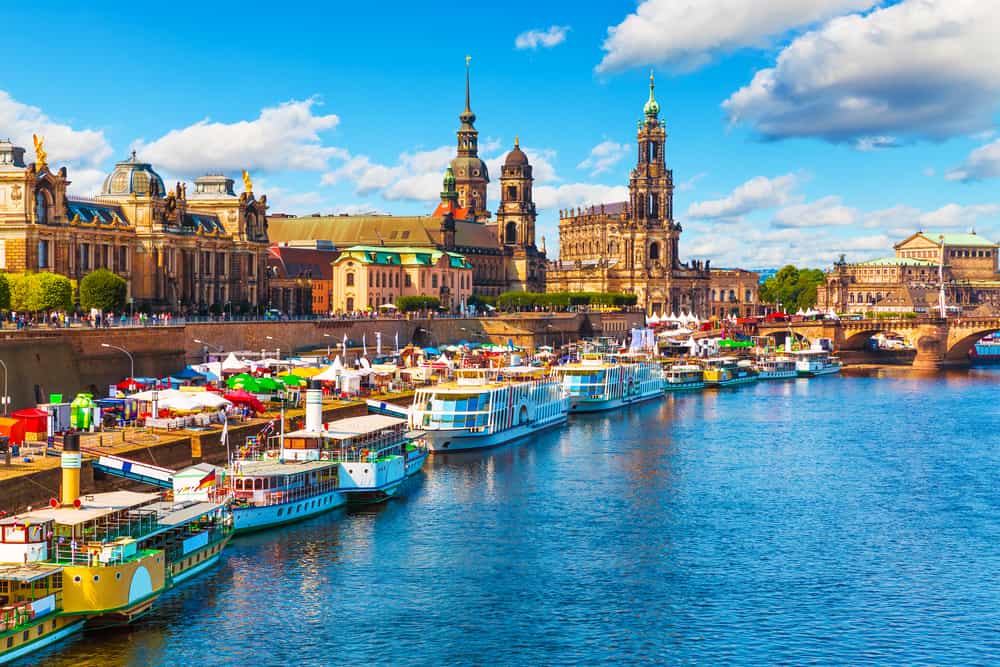
Scenic summer view of the Old Town architecture with Elbe river embankment in Dresden, Saxony, Germany
©Oleksiy Mark/Shutterstock.com
Land Size: 127 sq. miles (city)
Population: 555,000
Location: Dresden is the capital city of Saxony, a landlocked state in Germany. It is the fourth-largest city in the country by area and the 12th most populous. It lies in the Dresden Basin on the banks of the Elbe River.
What It’s Known For: Dresden is nicknamed “Florence on the Elbe.” The city is notable for its baroque architecture, art galleries, renowned museums, cultural landscape, opera, sports, and universities.
Best Tourist Attractions: Frauenkirche Dresden, Zwinger, Semperoper Dresden, Bruhl’s Terrance, Green Vault, Furstenzug, The Grand Garden of Dresden, Pillnitz Castle, and Callejon Del Arte
Bremen

Bremen, Germany is popular for medieval architecture, breweries Christmas markets, museums, and science centers.
©Ole Schoener/Shutterstock.com
Land Size: 4,489 sq. miles (metro), 126 sq. miles (city)
Population: 2.4 million (metro)
Location: Bremen is the second-largest city in Northern Germany; Hamburg is the first. It lies on the River Weser, with the inner city sitting on a Weser dune.
What It’s Known For: Bremen is a popular destination for medieval architecture, museums, breweries, science centers, Christmas markets, modern art, techno, football, and concerts.
Best Tourist Attractions: Universum Bremen, Bremen Market Square, Overseas Museum, Schnoor Historic District, St. Petri Dom Bremen, Galleria de Arte de Bremen, Town Musicians of Bremen, and Bremen Town Hall
Munich
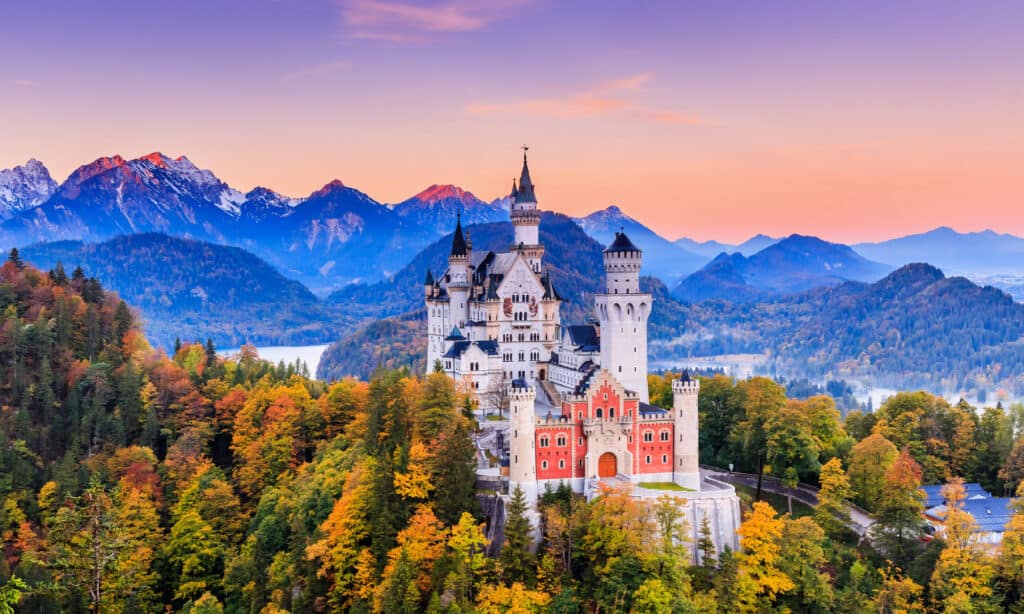
Munich is the capital city of Bavaria in Southeast Germany. It is the third-largest by population in Germany.
©iStock.com/sorincolac
Land Size: 119 sq. miles (city)
Population: 1.5 million (city)
Location: Located in Southeast Germany, Munich is the capital city of Bavaria and the third-largest city by population in Germany. Munich lies on elevated plains near the northern edge of the Alps.
What It’s Known For: The city of Munich is best known for its eclectic mix of architecture, royal avenues, elegant townhomes, public parks, sports, museums, art, literature, festivals, breweries, nightlife, and education.
Best Tourist Attractions: English Garden, Marienplatz, Victuals Market, Nymphenburg Palace, Munich Residenz, Deutsches Museum, Olympiapark Munchen, BMW Welt, and Frauenkirche
Munster

Muenster is considered the bicycle capital of Germany.
©Frantic00/Shutterstock.com
Land Size: 116 sq. miles (city)
Population: 317,000
Location: Munster is in the northern part of North Rhine-Westphalia state, where it is the state district capital. North Rhine-Westphalia is in Western Germany and Munster sits on the River Aa, with a landscape of dispersed farmland and mountain ridges.
What It’s Known For: Munster is notable for its gardens, shopping, churches, moated castles, bikes, museums, higher education, and many industries.
Best Tourist Attractions: Allwetterzoo Munster, Westphalian State Museum of Art & Cultural History, Iglesia, de San Lamberto, LWL Museum of Natural History, St. Paulus-Dom, Prinzipalmarkt, Botanical Garden of the Westphalian Wilhelm University of Munster, Historic City Hall, and Art Museum Pablo Picasso
Leipzig

Leipzig is a popular destination for nightlife, dancing, innovative music, contemporary art, and cuisine.
©iStock.com/FotografieLink
Land Size: 114 sq. miles (city)
Population: 601,000 (city)
Location: Leipzig is located in the state of Saxony in East Germany. It lies in the southernmost region of the North German Plain in Leipzig Bay.
What It’s Known For: Leipzig is popular for its nightlife, innovative music, dance scene, contemporary art, architecture, museums, gardens, sports, and cuisine.
Best Tourist Attractions: Monument to the Battle of the Nations, Zoo Leipzig, St. Thomas Church, St. Nicholas Church, Leipzig Panometer, Stadtgeschichtliches Museum Leipzig, Forum of Contemporary History, and Museum der Bildenden Kunste
Dortmund
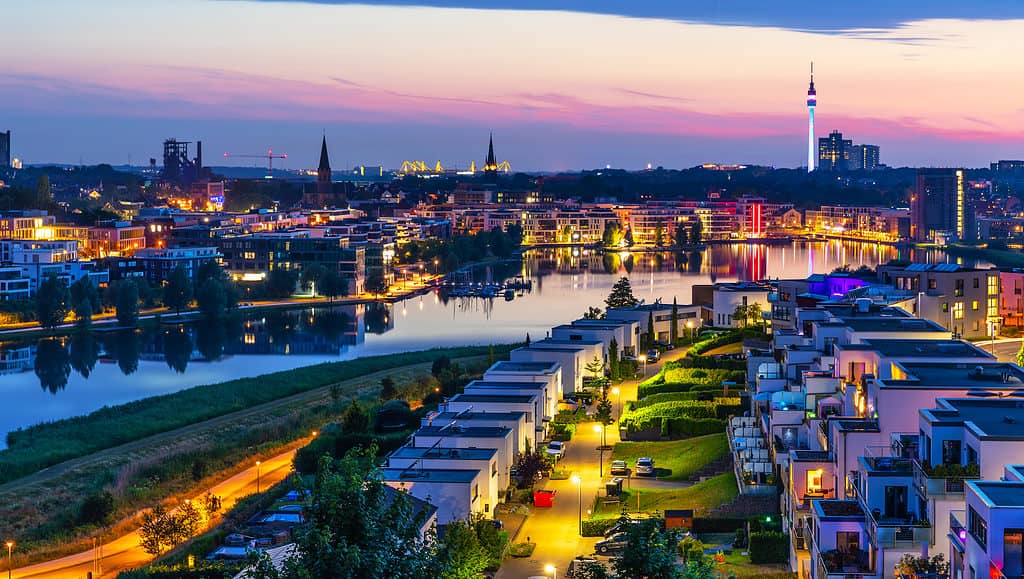
Dortmund features historic buildings, urban districts, shopping, fairs, and festivals.
©iStock.com/scanrail
Land Size: 2,806 sq. miles (metro), 108 sq. miles (city)
Population: 586,000 (city)
Location: Dortmund is the largest city by population and area of the Ruhr, a district in Northwest Germany. This independent city is part of the Westphalian Lowland and the Ardey Hills.
Notable For: Dortmund features historic buildings, post-war architecture, urban districts, castles, shopping, fairs, theater, museums, festivals, traditional cuisine, and sports clubs.
Best Tourist Attractions: Westfalenpark, LWL Industrial Museum Zollern, Signal Iduna Park, German Footbal Museum, Rombergpark Botanical Garden, Hohensyburg, DASA Working World Exhibition, St. Reinold’s church, and Thier-Galerie
Erfurt
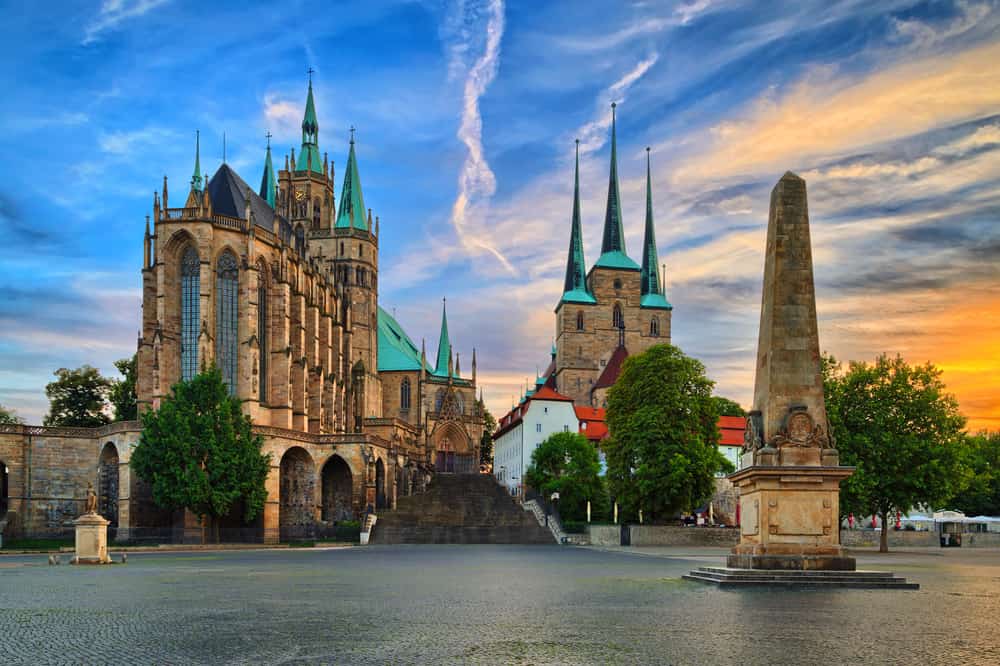
Erfort, Germany is the largest city in Central Germany.
©pixelliebe/Shutterstock.com
Land Size: 103 sq. miles (city)
Population: 213,000 (city)
Location: Erfurt is in Central Germany in the state of Thuringia, where it is the capital and largest city in the region. It lies in the valley of the Gera River in the southern portion of the Thuringian Basin.
Notable For: Erfurt is famous for its historic figures, contemporary musicians, museums, theater, secular architecture, monasteries, and fortifications.
Best Tourist Attractions: Erfurt Cathedral, Egapark, Besucherzentrum Zitadelle Petersberg, Thuringian Zoo Park, Domplatz Erfurt, Kramerbrucke, Old Synagogue, St. Severi Church, and Protestant Augustinian Monastery
Bielefeld
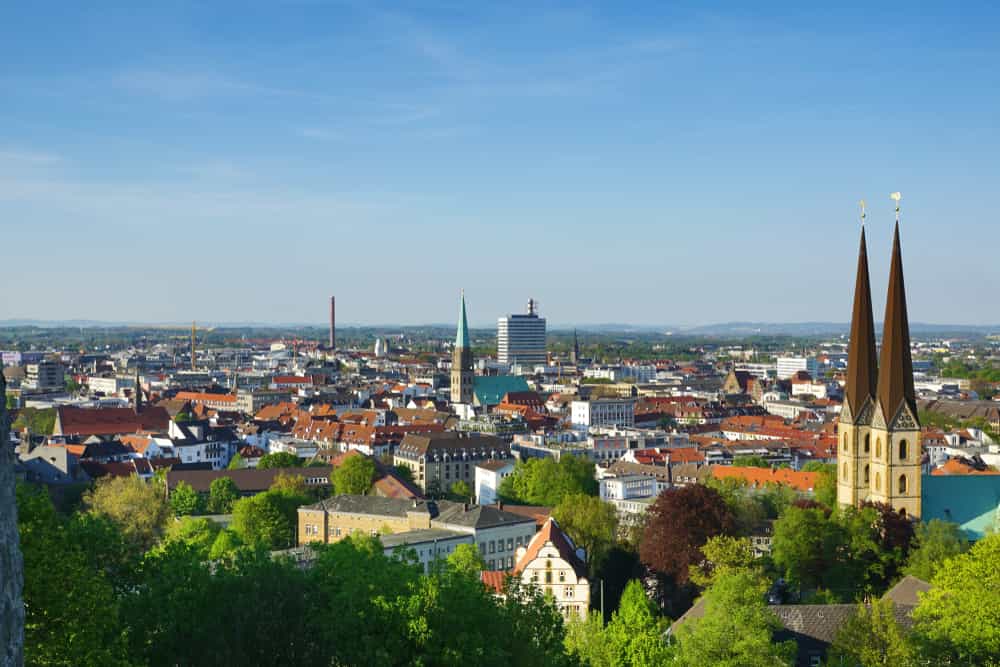
City view Bielefeld with Nikolaikirche and Neustädter Marienkirche
©Odessa25/Shutterstock.com
Land Size: 99 sq. miles (city)
Population: 334,000 (city)
Location: Bielefeld is in Eastern Germany in the Ostwestfalen-Lippe Region in North Rhine-Westphalia. Its historical center is north of the Teutoburg Forest, with an impressive hiking trail running through the city.
Notable For: Bielefeld has international companies, historical landmarks, museums, gardens, German Christmas carols, football, and many notable people.
Best Tourist Attractions: Heimat-Tierpark Olderdiseen, Sparrenburg Castle, Obersee, Dr. Oetker World, Laserzone, SchucoArena, Bielefeld Opera, and Botanical Garden
Summary of the 11 Largest Cities in Germany
Here’s a summary of the 11 largest cities in Germany, their land size, and population:
| Number | City | Land size | Population |
|---|---|---|---|
| 1 | Berlin | 11,794 sq. miles (metro), 344 sq. miles (city) | 6.1 million (metro) |
| 2 | Hamburg | 10,000 sq. miles (metro), 291 sq. miles (city) | 5.4 million (metro) |
| 3 | Cologne | 156 sq. miles (city) | 1 million (city) |
| 4 | Dresden | 127 sq. miles (city) | 555,000 |
| 5 | Bremen | 4,489 sq. miles (metro), 126 sq. miles (city) | 2.5 million (metro) |
| 6 | Munich | 119 sq. miles (city) | 1.5 million (city) |
| 7 | Munster | 116 sq. miles (city) | 317,000 |
| 8 | Leipzig | 114 sq. miles (city) | 601,000 (city) |
| 9 | Dortmund | 2,806 sq. miles (metro), 108 sq. miles (city) | 586,000 (city) |
| 10 | Erfurt | 103 sq. miles (city) | 213,000 (city) |
| 11 | Bielefeld | 99 sq. miles (city) | 334,000 (city) |
The photo featured at the top of this post is © iStock.com/FotografieLink
Thank you for reading! Have some feedback for us? Contact the AZ Animals editorial team.






